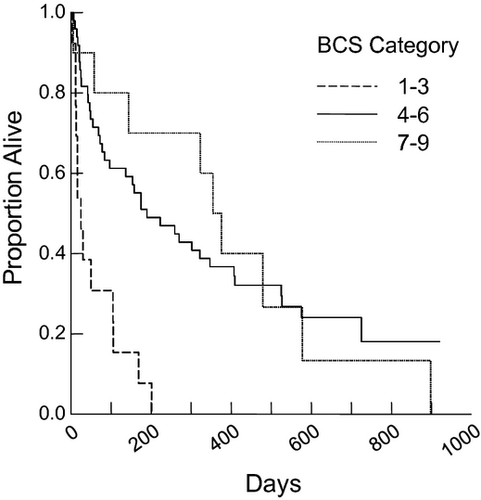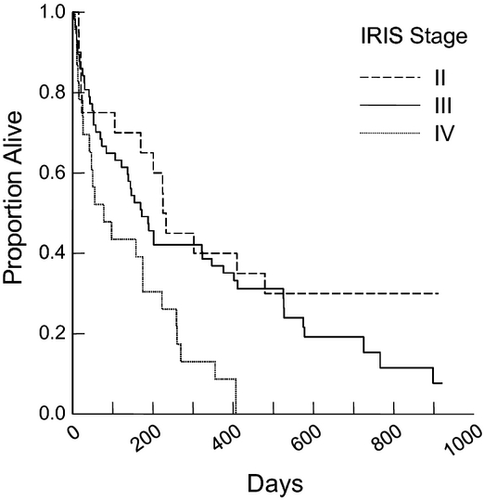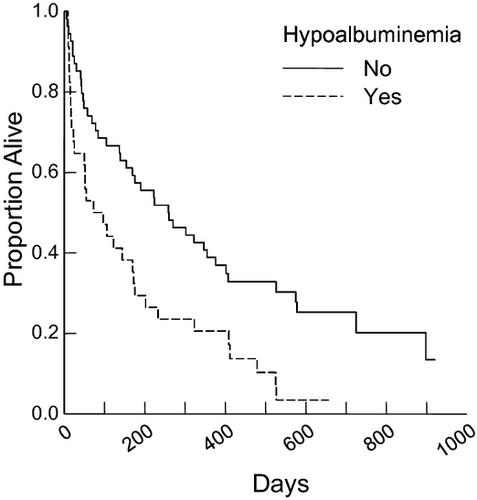Background
Obesity in people with chronic kidney disease (CKD) is associated with longer survival. The purpose of this study was to determine if a relationship exists between body condition score (BCS) and survival in dogs with CKD.
Hypothesis/Objectives
Higher BCS is a predictor of prolonged survival in dogs with CKD.
Animals
One hundred dogs were diagnosed with CKD (International Renal Interest Society stages II, III or IV) between 2008 and 2009.
Methods
Retrospective case review. Data regarding initial body weight and BCS, clinicopathologic values and treatments were collected from medical records and compared with survival times.
Results
For dogs with BCS recorded (n = 72), 13 were underweight (BCS = 1–3; 18%), 49 were moderate (BCS = 4–6; 68%), and 10 were overweight (BCS = 7–9; 14%). For dogs with at least 2 body weights recorded (n = 77), 21 gained weight, 47 lost weight, and 9 had no change in weight.
Dogs classified as underweight at the time of diagnosis (median survival = 25 days) had a significantly shorter survival time compared to that in both moderate (median survival = 190 days; P < .001) and overweight dogs (median survival = 365 days; P < .001). There was no significant difference in survival between moderate and overweight dogs (P = .95).
Conclusions and Clinical Importance
Higher BCS at the time of diagnosis was significantly associated with improved survival. Further research on the effects of body composition could enhance the management of dogs with CKD.
Abbreviations
-
- BCS
-
- body condition score
-
- CKD
-
- chronic kidney disease
-
- COPD
-
- chronic obstructive pulmonary disease
-
- ESRD
-
- end‐stage renal disease
-
- IRIS
-
- International Renal Interest Society
-
- ISU‐LVMC
-
- Iowa State University‐Lloyd Veterinary Medical Center
-
- TCSVM
-
- Tufts Cummings School of Veterinary Medicine
-
- UPC
-
- urine protein creatinine ratio
Obesity is a risk factor for the development of chronic kidney disease (CKD) in people. However, people with CKD and end‐stage renal disease (ESRD) who are overweight or obese have improved survival when compared to those who are normal‐weight or underweight. This concept has been labeled the “obesity paradox.” The obesity paradox appears to be well‐established in people with heart failure and also occurs in other diseases, such as chronic obstructive pulmonary disease (COPD) and rheumatoid arthritis.
The mechanism by which overweight and obesity exert a protective effect in these varied diseases is not completely understood but several theories are described. It is likely multifactorial, related to altered adipokine profiles, neurohormonal alterations, and medications used to treat concurrent diseases.
One important explanation for the obesity paradox is that obesity reflects higher muscle mass, or lack of cachexia, because obese people not only have more adipose tissue compared to lean people but also have more lean body mass. The detrimental effects of muscle loss in a variety of diseases are well documented. Therefore, this extra lean body mass associated with obesity can provide a greater reserve in CKD or other catabolic diseases.
The obesity paradox has been investigated in dogs and cats with heart failure. Dogs with heart failure that gained body weight had longer survival times compared to those that lost or maintained weight. In cats with heart failure, cats with low body weights had shorter survival times compared to cats with moderate or high body weights.
In the study of cats with heart failure, cats with the highest body weights also had reduced survival times, suggesting a U‐shaped relationship between body weight and survival, as compared to a more linear relationship in dogs with heart failure. Most studies of the obesity paradox in people with CKD and ESRD also have shown a more linear relationship, although some have demonstrated a U or J‐shaped curve.
Nutritional modification is a fundamental aspect of the management of CKD in dogs, and feeding a therapeutic veterinary renal diet has been shown to prolong survival and delay the onset of uremic crisis in dogs with naturally occurring CKD. However, the relationship between body condition and survival has not been reported in dogs with CKD. Therefore, the purpose of this study was to retrospectively examine the relationship between body condition, body weight changes, and survival in dogs with CKD with the hypothesis that body weight and body condition are associated with survival time.
Materials and Methods
Case Selection
Eligible cases were identified from a computer database search of dogs evaluated for CKD at Lloyd Veterinary Medical Center at Iowa State University (ISU‐LVMC) and Tufts Cummings School of Veterinary Medicine (TCSVM) between January 2008 and December 2009.
Dogs that were classified as International Renal Interest Society (IRIS) stage II (serum creatinine ≥1.4 mg/dL with inadequate urine concentrating ability [urine specific gravity < 1.030]) through stage IV during this time period were eligible.
Dogs < 1year of age, those that were azotemic without a urine specific gravity documented and those suspected to have a congenital kidney disease as evidenced by either age of diagnosis, diagnostic imaging results or histopathologic findings were excluded. Dogs that presented with acute renal failure or a suspected acute‐on‐chronic episode were excluded, as were those whose medical records lacked either a body weight or BCS during the initial visit.
Study Design
The medical record of each eligible dog was reviewed for information on the initial examination, and the following information abstracted using a standardized data collection form: signalment; body weight and BCS (on a 1–9 scale); hematocrit or packed cell volume (PCV); serum urea nitrogen, creatinine, phosphorus, potassium, albumin, urine protein:creatinine ratio (UPC); systolic blood pressure, and IRIS stage.
Changes in body weight were collected from the medical record (from the time of initial diagnosis of CKD until the last available body weight). To account for interobserver variability in body condition scoring, because multiple clinicans assessed BCS given the retrospective nature of the study, dogs were allotted to one of the 3 groups: underweigh (BCS 1–3), moderate weight (BCS 4–6), or overweight (BCS 7–9). Systemic hypertension was defined as a systolic blood pressure >160 mmHg.
The presence of anorexia (defined as decreased or absent appetite as reported by the owner) also was recorded. Information regarding medications, dietary supplements and diets used during the course of the disease also was recorded. In addition, survival time and cause of death/euthanasia were recorded. If the date of death was not available from the medical record, referring veterinarians or owners were contacted for this information.
Data Analysis
Data were examined graphically. Data that were normally distributed are presented as mean ± SD, whereas skewed data are presented as median and range. Categorical variables were compared among groups using the Chi‐squared test (or Fisher’s exact test, where appropriate). Survival times were calculated for all dogs that lived for at least 1 day and were discharged from the hospital.
Dogs that were still alive at the time of data analysis and dogs lost to follow‐up were censored for the purposes of survival analysis, with the last known date alive used for dogs lost to follow‐up. Kaplan‐Meier curves and log‐rank tests were used to compare survival time among dogs with different baseline BCS categories, as well as with body weight change categories.
The association between survival and any variables found to be P < .10 on univariate analysis also was analyzed using Cox proportional hazards models. Weight changes were categorized as weight loss (loss of >0.2 kg [0.5 pounds]; to account for scale variation), weight gain (gain of >0.2 kg) or no change (weight within 0.2 kg of initial weight). Statistical analysis was performed using a commercial statistical software package. P‐values ≤ .05 were considered statistically significant.
Results
One hundred dogs diagnosed with CKD in 2008–2009 were eligible for this study: (TCSVM: n = 75, ISU: n = 25). There were no significant baseline differences between dogs in age, sex, breed, body weight, BCS, or clinicopathologic variables at the 2 sites; therefore, all analyses were performed on pooled data from the 2 sites.
Breeds most commonly represented were Labrador Retriever (n = 15), mixed breed (n = 10), German Shepherd (n = 6), Shetland Sheepdog (n = 5), Cocker Spaniel (n = 4), Golden Retriever (n = 4) and Shih Tzu (n = 4). A variety of other breeds were represented in smaller numbers. Sixty‐two female (54 spayed) and 38 male (34 castrated) were included.
Mean age was 10.7 ± 3.5 years. At the time of diagnosis, dogs were classified as IRIS stage II (n = 20), stage III (n = 57) or stage IV (n = 23). At the time of diagnosis, median hematocrit or PCV = 35% (range, 10–56%), serum urea nitrogen = 74 mg/dL (range, 20–248 mg/dL), creatinine = 3.1 mg/dL (range, 1.5–11.5 mg/dL), phosphorus = 6.6 mg/dL (range, 2.4–33.7 mg/dL), potassium = 4.9 (range, 2.8–7.0), and albumin = 3.0 g/dL (range, 1.1–4.3 g/dL). Sixty‐seven dogs had proteinuria at the time of diagnosis (median UPC = 3.6 [range, 0.3–33.9]) and 36 of 68 dogs with blood pressure measurements had hypertension (median systolic blood pressure = 170 mmHg, range, 50–250 mmHg).
Medications administered over the course of the dogs’ disease varied and included H2 antagonists (n = 51), angiotensin converting enzyme inhibitors (n = 37), amlodipine (n = 22), phosphate binders (n = 15), aspirin (n = 7), and calcitriol (n = 2).
Thirty‐one dogs received subcutaneous fluids and 16 dogs received omega‐3 fatty acid supplementation. At the time of the 1st examination, 40 dogs were either already eating a veterinary therapeutic diet designed for dogs with renal disease or were prescribed this type of diet at the time of discharge. However, at the time of the last hospital visit, only 22 dogs were noted to be eating veterinary renal diet. Two dogs had a feeding tube placed during the course of their disease.
Fifty‐eight dogs were noted to be anorectic at the time of the initial visit. Median body weight at baseline was 19.4 kg (range, 2.4–50.1 kg). For dogs with BCS recorded at the time of initial diagnosis (n = 72), were underweight (18%), 49 were moderate (68%), and 10 were overweight (14%). Dogs in the different BCS categories were not significantly different in any variables measured, including age, sex, breed, or IRIS stage.
For dogs that had at least 2 body weights recorded over the course of their disease (n = 77), the change in weight over time ranged from a loss of 9.9 kg to a gain of 4.7 kg (median = −0.9 kg). The time from the first to last body weight was 165 days (median; range, 1–925 days). On a percentage basis from the initial body weight, the weight change was −6% (median; range, −34% to +21%). Forty‐two dogs (55%) lost ≥5% body weight. Forty‐seven (61%) dogs lost weight, 21 (27%) gained weight and 9 (13%) had no change in weight.
Seventeen dogs were still alive at the time of the analysis. For dogs that did not survive, 71 were euthanized and 7 died (information as to whether the dog died or was euthanized was not available for 3 cases); 2 dogs were lost to follow‐up. The most common causes of death were renal disease (n = 27), neurological disease (n = 6), and neoplasia (n = 5). The cause of death could not be determined for 41 dogs. Median survival time for all dogs was 174 days (range, 3–921 days).
Survival time was significantly related to BCS category (Fig 1) . Dogs classified as underweight had a significantly shorter survival time compared to both moderate (P < .001) and overweight dogs (P < .001). There was no significant difference in survival between moderate and overweight dogs (P = .95). IRIS stage at time of diagnosis was also significantly related to survival (Fig 2).
Dogs classified as IRIS stage IV at diagnosis had significantly shorter survival times than dogs classified as IRIS stages II or III (both P = .008). Survival for IRIS stages II and III was not significantly different. The presence of hypoalbuminemia was significantly associated with shorter survival (P = .003; Fig 3). Dogs that were fed a veterinary therapeutic diet had a significantly longer survival time compared to those not eating a renal diet (P = .03).
Other variables (eg, changes in body weight, proteinuria, hyperphosphatemia, hyperkalemia, anemia, hypertension, medications, or omega‐3 fatty acid supplementation) were not significantly associated with survival time.

Figure 1


Figure 3
Body condition score, BCS category (P = .02), IRIS stage (P = .03), and hypoalbuminemia (P = .03) remained significantly associated with survival in multivariate analysis.
Discussion
In this population of dogs with CKD, higher BCS at the time of diagnosis was significantly associated with improved survival. This is similar to results from studies of people with CKD and heart failure in which body mass index is used to assess the degree of obesity. However, these results are in contrast to a study of cats with heart failure in which BCS was not associated with survival.
However, in that study of cats, the sample size might have limited the power to detect a relationship between BCS and survival, as the pattern of BCS was similar to that for body weight (which was significantly correlated with survival). In a study of dogs with heart failure, there was no association between BCS and survival (P = .09).
Many chronic diseases, including CKD, primarily affect the lean body mass compartment. The BCS primarily assesses adipose tissue stores. A muscle condition score to specifically assess muscle stores of the dogs would be highly desirable but was not available in this retrospective study. Future studies of CKD and other chronic diseases should incorporate the use of a muscle condition score to more specifically assess the body compartment of greatest relevance in disease.
This score now is recommended as part of the assessment of all clinical animals in the new American Animal Hospital Association and World Small Animal Veterinary Association Nutritional Assessment Guidelines.
Changes in body weight (ie, weight gain versus weight loss versus no change in weight) were not significantly associated with survival in this population of dogs. This is in contrast to dogs with heart failure and people with CKD, in which survival is significantly associated with weight gain.
Of the dogs in this study that had at least 2 body weights recorded over the course of their disease, 61% lost weight, and 55% lost at least 5% of initial body weight (with dogs losing up to 21% of initial body weight). A loss of at least 5% body weight is one of the major criteria for a diagnosis of cachexia in people. However, as the lean body mass compartment is primarily affected, this use of weight likely underestimates cachexia as weight is an insensitive measure of muscle loss and can be masked by edema or ascites.
The ability to detect a relationship between changes in body weight and survival might be related to limitations of the study design. For example, not all dogs (77%) had 2 body weights, and the last body weight was taken at different time points for each dog (range, 1–925 days). Some variability also might have resulted from the use of different weighing scales.
In addition, body weight can vary as a result of fluid shifts; thus, body weight might have been affected by dehydration or third‐spacing of fluid. Many dogs were presented for evaluation of weight loss. However, if they did not have a prior diagnosis of CKD, their weight loss to that point could not be used to reflect the wasting seen with CKD and its effect on survival.
In addition to the positive association between BCS and survival, IRIS stage was negatively associated with survival time, similar to another study evaluating cats with CKD. Creatinine is affected by muscle mass though, so using creatinine in end‐stage muscle‐wasted patients might underestimate the degree of azotemia.
Hypoalbuminemia also was significantly associated with survival, similar to people with CKD and ESRD undergoing dialysis. This association might be attributed to the presence of malnutrition. Although nonspecific, albumin has often been used as a marker of malnutrition and is associated with shorter survival times in studies of human CKD patients and dogs. Malnutrition is a common problem in dogs with CKD. Further evaluation of albumin as a marker of nutritional status and predictor of mortality in dogs with CKD could be useful.
Dogs that were prescribed a veterinary therapeutic diet designed for dogs for renal disease at the time of the last visit had a significantly longer median survival time compared to that of dogs not recorded as eating one of these diets.
However, renal diet was not significant on multivariate analysis. One limitation of this finding is that diet history was not always recorded in the medical record. Nor could it be determined retrospectively if the dogs were actually eating the renal diets they were prescribed. Furthermore, owners frequently supplement their dogs’ diets with additional foods and treats, and this could have affected actual intake of the renal diets.
Omega‐3 fatty acid supplementation was not associated with survival in the current study, which is in contrast to dogs with heart failure in which omega‐3 fatty acid supplementation is associated with a longer survival time. As with the diet, this information was not always available from the medical record. In addition, commercial renal diets are often supplemented with omega‐3 fatty acids; however, it was not possible to accurately assess actual dietary intake of omega‐3 fatty acids (or the type of omega‐3 fatty acids ) from the medical records.
There are a number of other limitations to this study. The diagnosis of CKD required the documentation of azotemia with an inability to concentrate urine. Many dogs did not have concurrent urinalyses recorded at the first documentation of azotemia. This might have falsely delayed some dates of diagnosis, thus reducing survival times.
It is also sometimes difficult to accurately define “acute‐on‐chronic” versus acute versus CKD. Therefore, some eligible cases might have been excluded if they were incorrectly classified. Conversely, a small number of acute‐on‐chronic CKD cases might have been inadvertently included.
The retrospective design and relatively small sample size might have been inadequate to identify other factors associated with survival (eg, hypertension, proteinuria, clinicopathologic data, and medications). Therefore, prospective studies would be useful to specifically evaluate these other factors and their interrelationships with body composition.
These results suggest that body condition is an important consideration in dogs with acquired CKD. Further studies are warranted to evaluate the relationship between body composition and survival in dogs with CKD.

